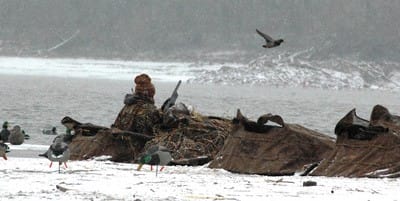
It was December, 1987, December 29, 1987 to be precise. For days, the temperatures had ranged between zero and nothing. Everything around the capital city of Columbus, Ohio, was frozen solid. Everything, that is, except the Scioto River, and that was being keep open by thousands of little orange duck feet. Weather be damned, it was time to hunt! The morning came bitterly cold. Three of us set decoys and, huddled around a coffee can filled with flaming charcoal briquettes, settled back to await the birds’ arrival. Fortunately, we didn’t have to wait long.
A small flock of mallards was first, and we dropped two. My black lab, Maggie, splashed into the frigid waters for the first, and with ice already forming on her undercarriage, wisely refused to retrieve the second. Tom’s autoloader was the next casualty. A dousing with hot coffee revived it, at least for one more volley, and then it was done.

Birds came and went, the three of us sharing the two still-functioning pump-guns until a full limit of greenheads lay in the snow. With Maggie watching from the relative warmth around our improvised heater, we hurriedly picked up the flash-frozen decoys and headed to the truck. “Doc,” I explained. “I don’t know what this is. All I know is we hunted ducks yesterday, and when I got home, my hand started tingling.”
This, it seemed, was the most interesting shades of grey I’d ever seen, a color the good doctor agreed was not normal. Severe frostbite, he explained. “You’re probably going to have some sensitivity in that hand for the rest of your life,” he said. “Oh, and by the way, you really shouldn’t have been outside yesterday. Didn’t you hear the weather advisories warning people to stay indoors unless it was absolutely necessary?” Smiling, I thought of all those mallards. “But it was necessary, Doc. It was necessary.”
My point is this: If you tough it out until the end of the season, regardless of what Mother Nature throws at you, there’s a good chance you’re going to experience some phenomenal hunting. However, there’s also a good chance that that action won’t come easy. Still, with determination, and a couple of tricks, putting a limit of ducks on your strap at the buzzer might become a little less the exercise in futility it may have been in the past. Experimentation = Experience
Traditionally, the rule of thumb regarding decoys was simply to increase the number of blocks as the season progresses. The problem with this theory is the birds have learned about this through repetition. Instead, throw them a curve and use a dozen of your best-looking decoys set in an ultra-realistic pattern. Remember, too, the late season usually coincides with a peak in many species’ breeding cycles. You might want to be sure that eight of those 12 mallard decoys are hens.

Two final notes about late-season decoy spreads. Realism, as I’ve mentioned, is paramount now, and there’s nothing more realistic than movement. Certainly, that modern marvel, the spinning wing decoy, can add that movement. However, in those states where they’re legal, everybody and his brother has one. My recommendation is to use a jerk-cord. Jerk cords can be extremely effective tools for the late-season gunner, and one which, due to the influx of battery-powered motion-makers, the birds haven’t seen every day.
And finally, The Coot Rig. I’ve put together a spread of two dozen Greenhead Gear coots, and won’t hesitate to use those alone. When running a coot spread, I’ll do two things. First, I’ll set three or four magnum mallard decoys, widely spaced, downwind of the coot decoys. And secondly, I use an all-black decoy in my jerk cord. Coots are constantly in motion, and a bobbing coot in the spread not only imparts motion, but looks natural.
Calling in the Cold
A mediocre caller myself, I can hang during the early season, but I’ll make some changes as the season winds down. First, if I’m hunting with a good caller, I’ll let him call, that is. Secondly, I’ll use a mallard hen call very sparingly, and then only as an attention getter. Once I have the birds’ attention, I’ll change to something other than a hen mallard. Phil Robertson’s drake mallard and Pintail/Widgeon are two of my favorites. These soft subtle calls, when combined with a jerk cord, can make the difference.
Late season waterfowling can be frustrating. The birds are educated, the weather’s often less than perfect, and you’re at your wit’s end as to what to do. Well, folks, it’s really no secret as to what to do with these birds on ice—do something different.







